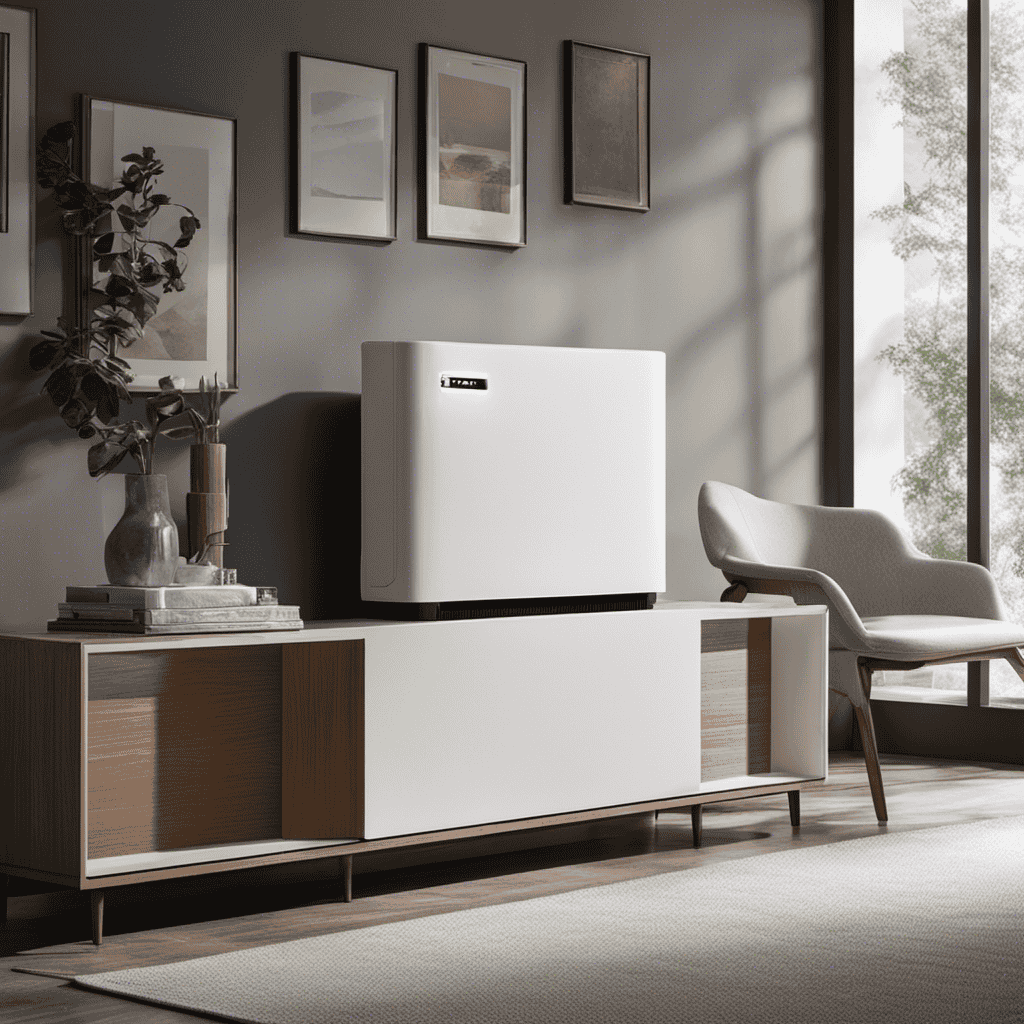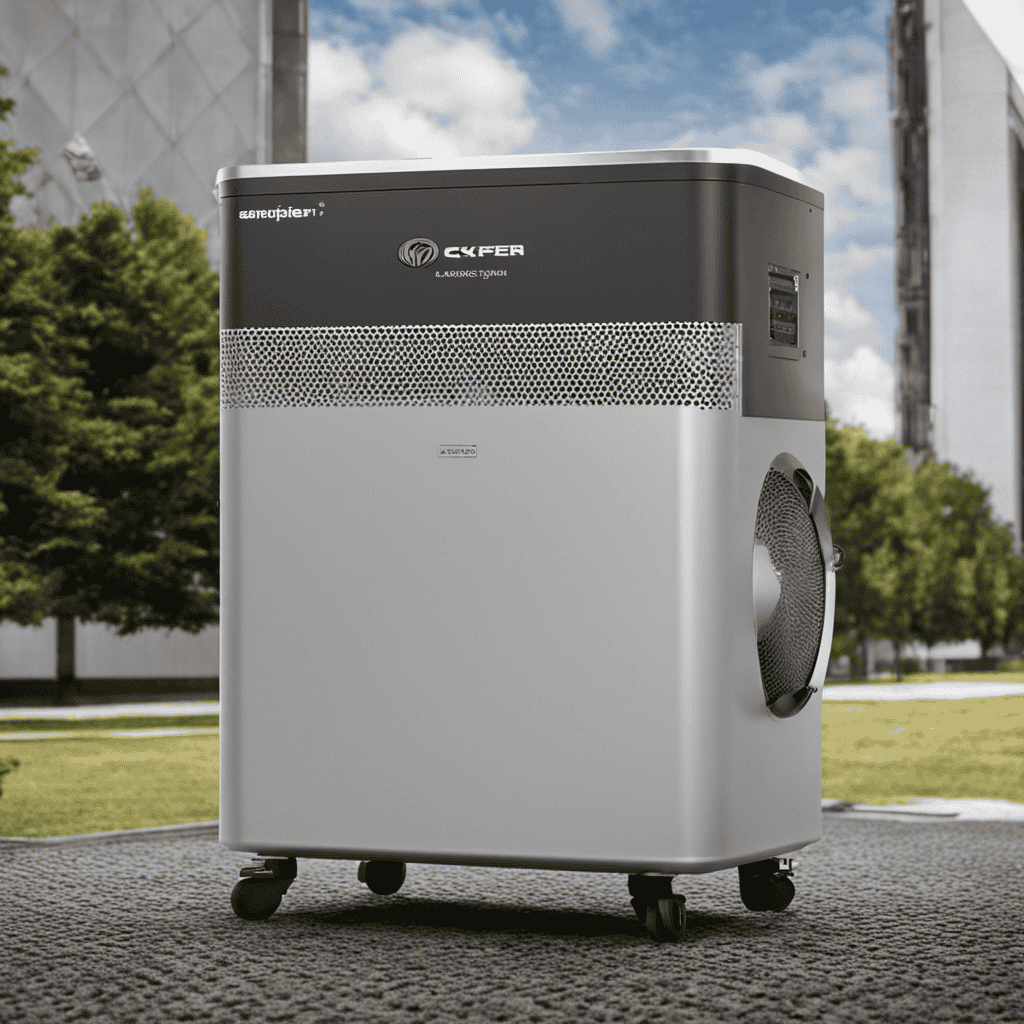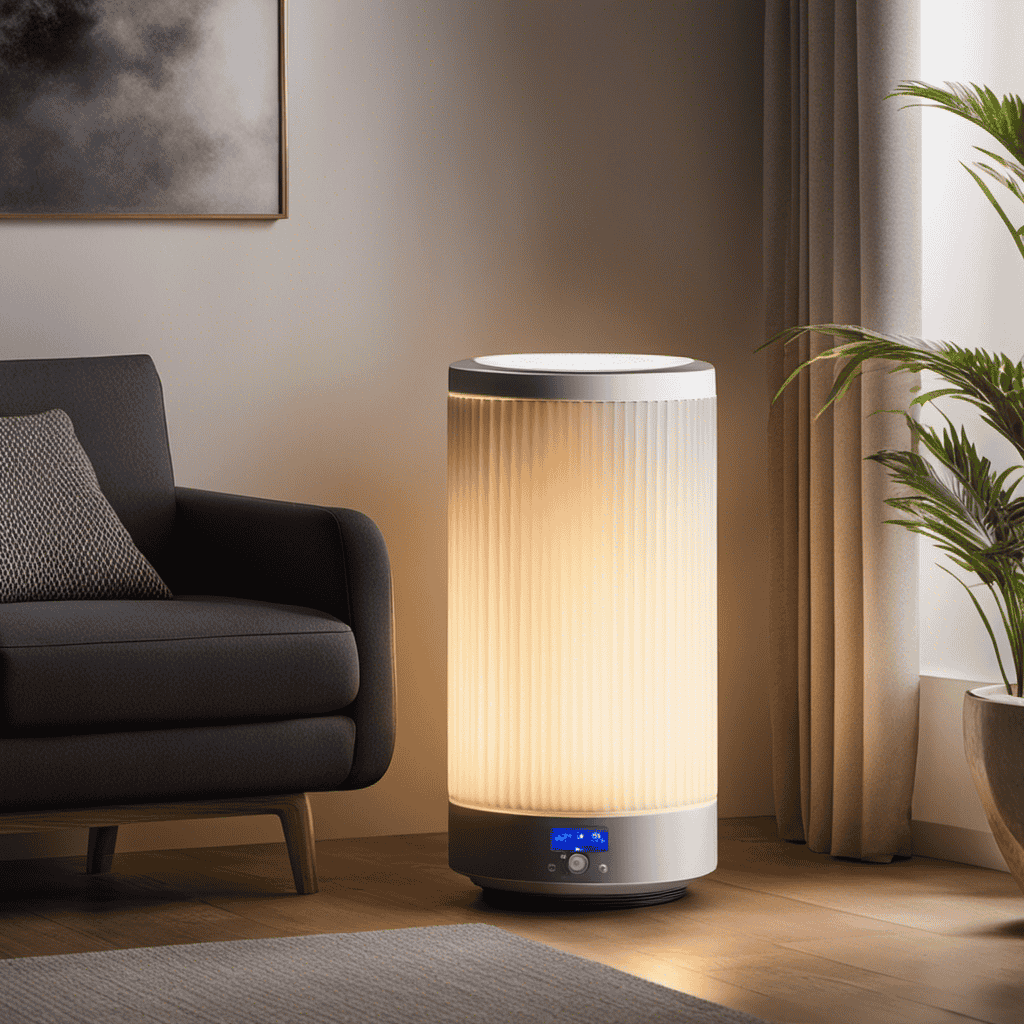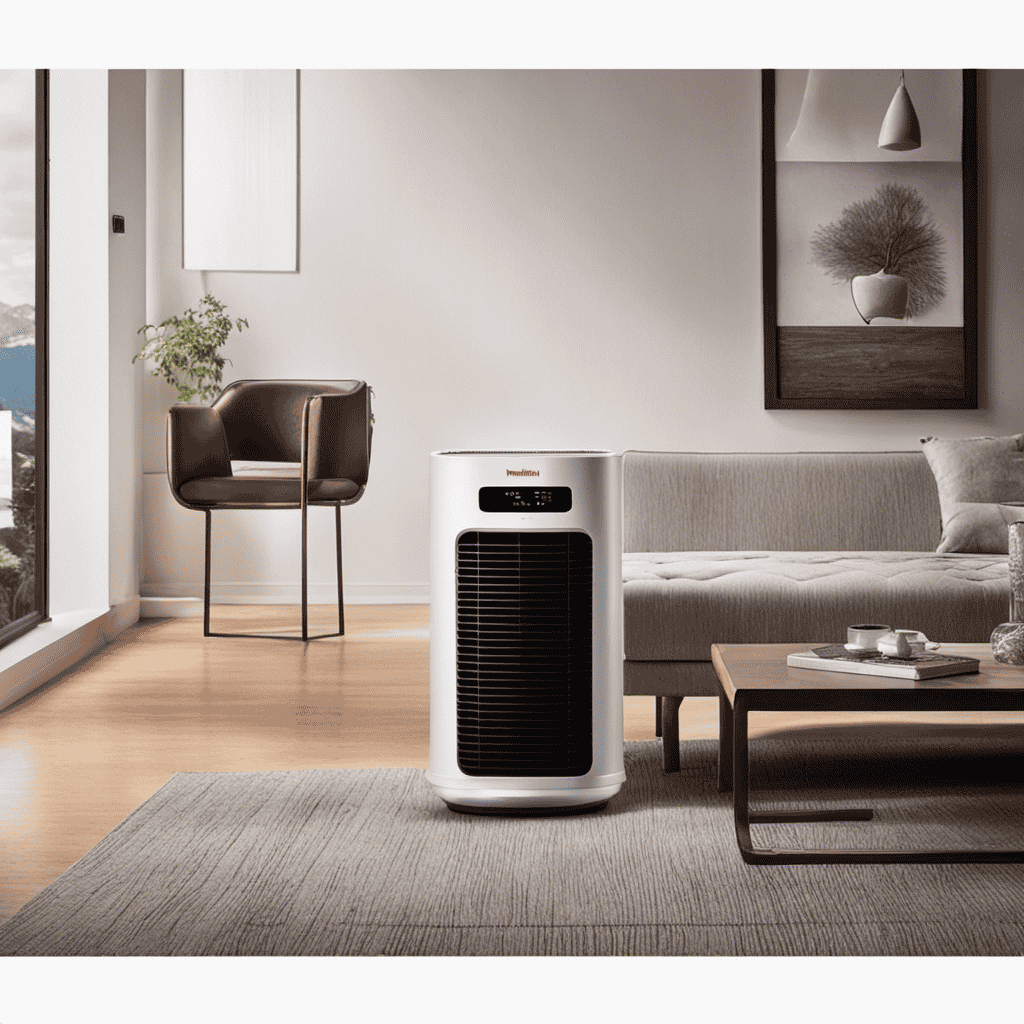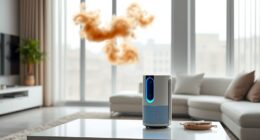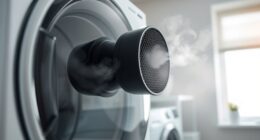As a fan of air purifiers, I have often pondered how to truly determine if my air purifier is working effectively. Are there any specific signs that show its efficiency?
In this article, we’ll explore the key indicators that can help you discern whether your air purifier is actually working. From checking the Air Quality Index (AQI) to assessing the air purification technology, we’ll delve into the technical aspects and provide you with the knowledge you need to make an informed decision.
Key Takeaways
- Check the Air Quality Index (AQI)
- Assess the Air Purification Technology
- Monitor the Fan Speed
- Look for Visible Signs of Dust or Allergens
Check the Air Quality Index (Aqi
To check if your air purifier is working, you can simply look at the Air Quality Index (AQI). The AQI is a measurement that indicates the level of air pollution in a specific area. It provides information about the quality of the air you breathe and can help you determine if your air purifier is effectively eliminating pollutants.
By regularly monitoring the AQI, you can assess the efficiency of your air purifier and make necessary adjustments to maintain its optimal performance. Air purifier maintenance is crucial in ensuring its effectiveness in improving indoor air quality.
In the next section, we will discuss how to assess the air purification technology used in your device to further evaluate its performance.
Assess the Air Purification Technology
Check if the air purifier’s technology effectively filters out pollutants.
With the advancements in air purification technology, it’s important to understand how it works and the benefits it brings.
Air purifiers use various technologies such as HEPA filters, activated carbon filters, and UV lights to effectively remove harmful particles and pollutants from the air.
HEPA filters are designed to capture particles as small as 0.3 microns, including dust, pollen, pet dander, and mold spores.
Activated carbon filters help eliminate odors, gases, and volatile organic compounds (VOCs).
UV lights are effective in killing bacteria, viruses, and other microorganisms.
Monitor the Fan Speed
Make sure you’re aware of the fan speed on your air purifier to ensure optimal performance. Monitoring the fan speed is crucial for checking the performance and effectiveness of your air purifier.
The fan plays a vital role in circulating the air and pushing it through the filtration system. By monitoring the fan speed, you can ensure that the air purifier is functioning at its intended level.
A lower fan speed may indicate a reduced airflow, which could affect the purification process. On the other hand, a higher fan speed may indicate a more efficient air purification process.
Look for Visible Signs of Dust or Allergens
You’ll want to keep an eye out for any visible signs of dust or allergens in order to determine the effectiveness of your air purifier.
One of the main purposes of an air purifier is to improve room cleanliness by removing airborne particles such as dust, pollen, and pet dander.
If you notice a significant reduction in these visible particles, it indicates that your air purifier is doing its job effectively.
On the other hand, if you see a buildup of dust or allergens on surfaces or in the air, it may be a sign that your air purifier needs maintenance.
Regular cleaning and filter replacement are essential for optimal air purifier performance.
Measure the Noise Level
When evaluating the effectiveness of an air purifier, one important factor to consider is the noise level it produces. In general, a louder purifier indicates that it is working harder to clean the air, and therefore suggests that it is more effective at removing pollutants.
On the other hand, if an air purifier is silent or produces very little noise, it may suggest that it is not effectively capturing and filtering particles, and thus may not be performing at its optimal level.
Therefore, the sound emitted by an air purifier can serve as a useful performance indicator.
Noise Indicates Effectiveness
Listen closely to the noise the air purifier is making – a louder sound indicates greater effectiveness. When it comes to determining whether an air purifier is working, sound analysis can be a helpful tool. By carefully listening to the noise it produces, you can gain insights into its performance.
Many air purifiers have different fan speeds or modes, and each mode may generate a different level of noise. Customer reviews can also provide valuable information about the noise levels of various air purifiers. Some customers may mention the noise in their reviews, giving you an idea of what to expect.
However, it’s important to consider that noise is not the only factor in determining an air purifier’s effectiveness. Other factors, such as CADR (Clean Air Delivery Rate) and filtration technology, should also be taken into account.
Silence Suggests Poor Performance
When it comes to air purifiers, silence can actually suggest poor performance. A quiet air purifier may seem like a desirable feature, but it can also be an indication that the device is not effectively cleaning the air.
Air purifiers work by drawing in air and passing it through filters to remove pollutants. This process generates a certain amount of noise, especially when the air purifier is running at higher speeds to tackle more polluted areas.
So, if your air purifier is completely silent, it may mean that it is not effectively capturing and removing pollutants from the air.
Therefore, when choosing an air purifier, it is important to find a balance between noise and performance, ensuring that the device is effectively cleaning the air while still maintaining an acceptable level of noise.
Sound as Performance Indicator
To gauge the performance of an air purifier, you can rely on sound as an indicator. The sound performance of an air purifier can give you valuable insight into its air purification effectiveness.
When an air purifier is running efficiently, it should produce a low, steady hum. This indicates that the motor and fan are working properly, drawing in air and filtering it effectively.
However, if you notice loud or irregular noises coming from your air purifier, it could be a sign of a problem. It could indicate a clogged filter, a malfunctioning motor, or an issue with the fan. In such cases, it’s important to address the issue promptly to ensure optimal air purification and maintain the longevity of your air purifier.
Test the Air Flow Rate
Accurate airflow measurement is crucial when assessing the effectiveness of an air purification system. It allows us to determine the rate at which air is being circulated and filtered, helping us understand how well the system is performing.
In addition to accurate measurement, effective air purification relies on the ability of the system to remove pollutants and improve indoor air quality.
Accurate Airflow Measurement
One way to determine if an air purifier is working properly is by measuring its airflow. Accurate airflow measurement is crucial in determining the effectiveness of an air purifier. Here are three key factors to consider when measuring airflow accuracy:
-
Use a calibrated airflow meter: To ensure accurate readings, it is important to use a calibrated airflow meter. This device is specifically designed to measure the airflow rate of an air purifier.
-
Measure at different settings: To fully assess the effectiveness of an air purifier, measure the airflow at different fan speed settings. This will provide a comprehensive understanding of its performance.
-
Compare with manufacturer specifications: Check the manufacturer’s specifications for the expected airflow rate of the air purifier. By comparing the measured airflow with the specified rate, you can determine if the device is working as intended.
Accurate airflow measurement is essential in determining the effectiveness of an air purifier.
Now, let’s explore the next section on effective air purification methods.
Effective Air Purification
When choosing an air purifier, you’ll want to consider the effectiveness of its purification methods. One important factor to consider is the room size and efficiency of the air purifier. You need to make sure that the purifier is capable of effectively cleaning the air in the room you intend to use it in. Look for information on the recommended room size for the purifier and compare it to the size of your room.
Another factor to consider is the noise level and performance of the air purifier. Some purifiers can be quite loud, which can be disruptive if you plan to use it in a bedroom or office. Additionally, it’s important to evaluate the purifier’s performance in terms of how quickly and effectively it removes pollutants from the air. Look for models with high CADR (clean air delivery rate) ratings, as this indicates a more efficient purifier.
Evaluate the Filter Lifespan
It’s important to regularly check the filter lifespan to determine if an air purifier is still working effectively. Evaluating the maintenance requirements of your air purifier is crucial in ensuring its optimal performance. Here are some key factors to consider:
-
Type of filter: Different air purifiers use different types of filters, such as HEPA filters, activated carbon filters, or electrostatic filters. Understanding the characteristics and lifespan of each filter type is essential in assessing its effectiveness.
-
Replacement schedule: Each filter has a recommended replacement schedule provided by the manufacturer. Following this schedule is crucial to maintain the air purifier’s efficiency. Regularly checking the filter’s lifespan and replacing it when necessary will help ensure clean and purified air.
-
Air quality indicators: Some air purifiers come with built-in air quality indicators that monitor the filter’s condition. These indicators provide real-time data on the air quality and can help you determine if the filter needs replacement.
Consider the Room Size and Coverage Area
When it comes to choosing an air purifier, considering the room size and coverage area is crucial for ensuring its effectiveness.
The size of the room directly affects how well the air purifier can clean the air, as a larger room may require a higher CADR (Clean Air Delivery Rate) to effectively remove pollutants.
Additionally, it is important to consider the coverage area of the air purifier, which refers to the maximum square footage it can effectively clean. This will determine if it can adequately clean the air in the entire room or only a portion of it.
Room Size and Effectiveness
Determining the room size is crucial in assessing the effectiveness of an air purifier. To ensure optimum performance, it is important to understand the room size limitations of your air purifier. Here are three key considerations for room size and air purifier effectiveness:
-
Square footage: Measure the square footage of the room where you plan to use the air purifier. Most air purifiers have a recommended maximum square footage they can effectively cover. Exceeding this limit may result in reduced efficiency.
-
Air changes per hour (ACH): ACH refers to the number of times the air in a room is cleaned by the purifier in one hour. To maintain clean air, the recommended ACH rate is typically 4 to 6 times for allergy sufferers and 2 to 4 times for general use.
-
Air purifier maintenance: Regular maintenance is essential for optimal performance. This includes cleaning or replacing filters, checking for any malfunctions, and ensuring proper ventilation around the unit.
Understanding these factors will help you determine the appropriate air purifier size for your room and ensure its effectiveness in improving indoor air quality.
Moving forward, let’s explore the importance of coverage area in choosing an air purifier.
Coverage Area Importance
To ensure the effectiveness of your air purifier, consider the importance of coverage area when selecting the right unit for your room. The size of your room directly affects the performance of your air purifier. A unit that is too small for your room will not be able to effectively clean the air, while a unit that is too large may be unnecessary and inefficient. To determine the appropriate coverage area for your air purifier, you can refer to the manufacturer’s recommendations or use a simple calculation. Measure the length and width of your room, and multiply these dimensions together to get the square footage. Then, compare this number to the coverage area specified by the air purifier. By selecting an air purifier that matches the size of your room, you can maximize its effectiveness and ensure that you are breathing clean and purified air.
| Room Size (sq ft) | Recommended Coverage Area (sq ft) |
|---|---|
| Up to 100 | 100-150 |
| 100-200 | 150-300 |
| 200-400 | 300-600 |
Compare Before and After Air Quality Tests
It’s important to compare the results of air quality tests before and after using an air purifier to determine its effectiveness. This comparison allows you to assess the impact of the purifier on the air pollutant levels in your environment.
Here are three key factors to consider when conducting these tests:
-
Measure air pollutant levels: Use a reliable air quality monitor to measure the concentration of pollutants such as dust, pollen, and volatile organic compounds (VOCs) in the air before and after using the air purifier. This will help you evaluate the purifier’s ability to reduce these contaminants.
-
Compare noise levels: Pay attention to the noise levels produced by the air purifier during operation. A good air purifier should operate quietly, allowing you to enjoy a peaceful environment while it cleans the air.
-
Assess overall air quality improvement: Compare the air quality test results before and after using the air purifier to determine the overall improvement in air quality. Look for significant reductions in pollutant levels to ensure the effectiveness of the purifier.
Note Any Improvement in Allergy Symptoms
After using the air purifier for a few weeks, I noticed a significant reduction in my sneezing frequency. Before, I used to sneeze multiple times a day, but now it has decreased to just a few sneezes here and there.
Additionally, my nasal passages feel much clearer, allowing me to breathe more easily.
Lastly, the air purifier has greatly diminished the irritation in my eyes, which used to be red and itchy on a daily basis.
Overall, these improvements in my allergy symptoms make me confident that the air purifier is effectively removing allergens from the air.
Reduced Sneezing Frequency
You can tell if the air purifier is working by noticing a decrease in how often you sneeze. When the air purifier is effectively removing allergens and pollutants from the air, it can lead to a reduction in coughing and improved breathing.
Here are three key indicators that your air purifier is doing its job:
-
Decreased sneezing: If you find yourself sneezing less frequently after using the air purifier, it means that it is successfully capturing and filtering out airborne irritants.
-
Improved sleep quality: A well-functioning air purifier can help create a cleaner and healthier sleeping environment, leading to better quality sleep and reduced respiratory discomfort.
-
Reduced allergy symptoms: If you experience a noticeable decrease in other allergy symptoms, such as itchy eyes or a runny nose, it suggests that the air purifier is effectively removing allergens from the air.
Clearer Nasal Passages
A well-functioning air purifier can lead to clearer nasal passages by reducing sneezing frequency and removing allergens from the air. When the air is free of irritants such as dust, pollen, and pet dander, our sinuses can stay clear, allowing for improved breathing. A clear sinus means that the air can flow freely through our nasal passages, reducing congestion and discomfort. This can be especially beneficial for individuals with allergies or respiratory conditions. In fact, studies have shown that using an air purifier can significantly reduce nasal symptoms and improve overall respiratory health. By capturing and trapping airborne particles in its filters, an air purifier creates a cleaner environment that promotes clear sinuses and easier breathing.
| Clearer Nasal Passages | |
|---|---|
| Key | clear sinuses |
| improved breathing |
With clearer nasal passages, we can experience the benefits of improved breathing. The air we breathe becomes fresher and cleaner, allowing our lungs to function more efficiently. As a result, we may notice reduced coughing, less wheezing, and an overall sense of wellbeing. Breathing becomes easier, and we can enjoy a better quality of life. However, it’s important to choose the right air purifier for your needs and to properly maintain it to ensure optimal performance. In the next section, we will explore how a well-functioning air purifier can also lead to diminished eye irritation, another common issue caused by airborne irritants.
Diminished Eye Irritation
When my nasal passages cleared up after using an air purifier, I realized that my eye irritation also seemed to diminish. I did some research and discovered that improved air circulation can have a positive effect on eye health.
Here are a few reasons why an air purifier can help with eye irritation:
- Reduced airborne irritants: Air purifiers filter out allergens, dust, and other particles that can cause eye irritation.
- Decreased indoor pollutants: By removing pollutants like smoke and chemicals from the air, air purifiers create a cleaner environment that is less likely to irritate the eyes.
- Balanced humidity levels: Some air purifiers have built-in humidifiers that maintain optimal humidity levels, preventing dryness and discomfort in the eyes.
With these benefits, it’s no wonder that using an air purifier can lead to diminished eye irritation and improved overall eye health.
Analyze the Odor Reduction Capabilities
To determine if an air purifier is effective in reducing odors, sniff the air in the room and see if there is a noticeable difference. However, to truly analyze the odor reduction capabilities of an air purifier, a more thorough and technical approach is necessary. One method is to conduct an odor reduction analysis, which involves measuring the effectiveness of the air purifier in removing specific odors from the air. This can be done by introducing a controlled amount of a particular odor into the room and then monitoring how well the air purifier removes that odor over time. The effectiveness measurement can be quantified using a scale or rating system, with a higher rating indicating better odor reduction capabilities.
| Odor Type | Initial Concentration (ppm) | Final Concentration (ppm) |
|---|---|---|
| Smoke | 10 | 2 |
| Pet | 20 | 5 |
| Cooking | 15 | 3 |
Examine the Filter for Dirt and Debris
Check the filter of your air purifier regularly for dirt and debris to ensure optimal performance. The filter plays a vital role in trapping pollutants and improving indoor air quality.
To analyze filter effectiveness and test air purification efficiency, follow these steps:
- Remove the filter from the air purifier carefully.
- Inspect the filter for any visible dirt, dust, or debris.
- Tap the filter gently to dislodge any trapped particles.
By examining the filter, you can determine if it needs cleaning or replacement. A dirty or clogged filter can hinder the air purifier’s ability to effectively remove pollutants from the air.
Regular maintenance of the filter will ensure that your air purifier continues to operate at its best, providing you with clean and fresh indoor air. Remember, a clean filter is essential for optimal air purification efficiency.
Monitor the Filter Replacement Indicator
Now that we’ve examined the filter for dirt and debris, let’s move on to the next step in determining if an air purifier is working effectively – monitoring the filter replacement indicator.
Most modern air purifiers are equipped with a filter replacement indicator that alerts you when it’s time to change the filter. This indicator is typically a light or a display that illuminates or changes color when the filter needs to be replaced.
It’s important to pay attention to this indicator as it ensures that your air purifier continues to operate at its optimal level and maintain good indoor air quality. By regularly checking the filter replacement indicator and promptly replacing the filter as needed, you can be confident that your air purifier is working efficiently and effectively to clean the air in your home.
Assess the Energy Consumption
Assessing the energy consumption of an air purifier is crucial in ensuring its efficiency. By monitoring its energy usage, you can determine if it is cost effective. Here are three key factors to consider:
-
Energy Star Certification: Look for the Energy Star label on the air purifier. This certification indicates that the device meets strict energy efficiency guidelines set by the EPA.
-
Power Consumption: Check the power consumption of the air purifier. Look for models with lower wattage, as they tend to consume less energy while still providing effective air purification.
-
Additional Features: Consider the additional features of the air purifier, such as adjustable fan speeds or programmable timers. These features can help optimize energy usage by allowing you to customize the device’s operation according to your needs.
Assessing the energy consumption of an air purifier is essential to ensure its energy efficiency and cost effectiveness. By considering factors like Energy Star certification, power consumption, and additional features, you can make an informed decision and choose an air purifier that not only provides clean air but also minimizes energy usage and saves you money.
Consult Professional Air Quality Testers or Experts
Consulting professional air quality testers or experts can provide valuable insights and guidance on improving the air quality in your home.
Air quality testing benefits are numerous and can help identify potential pollutants and contaminants in the indoor environment.
These experts have the necessary knowledge and tools to conduct thorough assessments and measurements, including sampling the air for pollutants, checking ventilation systems, and identifying sources of indoor pollution.
By consulting with these professionals, you can gain a better understanding of the specific air quality issues in your home and receive recommendations on how to address them effectively.
They can also provide guidance on selecting and using air purifiers, ensuring that you invest in a device that meets your needs and effectively improves the air quality in your living space.
Overall, consulting experts in air quality testing can ensure that you take the necessary steps to create a healthier and safer indoor environment for you and your family.
Frequently Asked Questions
Can an Air Purifier Completely Eliminate All Dust and Allergens From a Room?
An air purifier can greatly reduce dust and allergens in a room, but it may not eliminate them completely. Regular cleaning and maintenance are necessary to ensure the effectiveness of the purifier and reap the benefits of using one.
How Long Does It Typically Take for an Air Purifier to Show Noticeable Improvements in Air Quality?
It typically takes about 2-3 days to notice improvements in air quality when using an air purifier. To speed up effectiveness, ensure you choose the right size purifier for your space.
Do Air Purifiers Remove Odors From Cooking or Smoking?
Air purifiers can effectively remove odors from cooking or smoking by capturing and trapping the particles causing the smell. They are also effective in removing pet dander and mold spores, improving overall air quality.
What Is the Recommended Filter Replacement Frequency for an Air Purifier?
I always wondered about the recommended filter replacement frequency for my air purifier. It’s important to maintain its efficiency. Regularly changing the filters ensures cleaner air and a healthier environment for me and my family.
Are There Any Potential Health Risks Associated With Using an Air Purifier for Extended Periods of Time?
Using an air purifier for extended periods may have potential side effects and long-term health effects. It’s important to research and follow manufacturer guidelines to ensure safe and effective use.
What are the signs that indicate an air purifier is effectively cleaning the air?
One of the easiest ways to check air purifier efficiency is to look out for reduced dust and pollen particles in the air. Another way is to notice improved air quality and reduced odors. You can also use an air quality monitor to measure the air purity level. This is how to check air purifier effectiveness.
Conclusion
In conclusion, determining whether an air purifier is working effectively requires careful observation and assessment.
By checking the Air Quality Index (AQI), monitoring the fan speed, examining the filter for dirt and debris, and assessing the energy consumption, you can ensure the purifier is doing its job.
Remember the wise adage, ‘Trust, but verify,’ and consult professional air quality testers or experts for a thorough evaluation.
Stay informed and take control of your indoor air quality for a healthier and cleaner environment.
